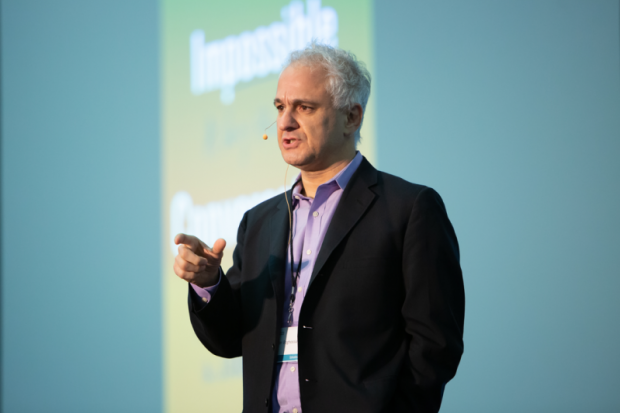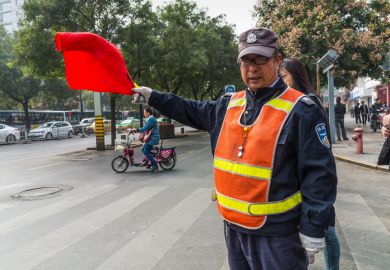When Australians insist that local factors bear little resemblance to those that drove Peter Boghossian out of US academia, he has a four-word response: “You’re a year behind.”
The American philosopher gained prominence – or notoriety, depending on one’s viewpoint – as a perpetrator of the “grievance studies” hoaxes. He and his co-authors concocted more than 20 absurd journal articles and managed to get some of them published to demonstrate what they saw as a lack of rigour in fields such as gender studies, critical race theory and intersectional feminism.
Lately, Dr Boghossian has been travelling the world demonstrating his technique of structured dialogue to help shift intractable debates. In the process, he has observed the higher education systems of Romania, Hungary and, most recently, Australia, where he spent several weeks as a guest of the University of Technology Sydney (UTS).
While some Sydneysiders expressed reservations about trends in their own universities, they doubted that things were irretrievable. Dr Boghossian dismissed this as a “Pollyanna” view.
“This conversation is reminiscent of one that we would have had in the US a year ago,” he said. “You’re going to look back [at the current period] with nostalgia.”
His disenchantment with universities is as much about their administrative processes as it is the “ideological capture” of their research, with disciplinary proceedings – such as those launched against him by former employer Portland State University – he sees as deployed to keep wandering minds in line.
“There are mechanisms within the institution designed to quell dissent,” he said. “They weaponise an office against you. It threatens a colossal waste of time if someone even thinks about violating the orthodoxy.”
According to Dr Boghossian, the branch most frequently weaponised is the diversity, equity and inclusion (DEI) office – an edifice inimical to free enquiry, he argues. “You cannot simultaneously have offices of DEI and free speech.
“Challenges to the orthodoxy [are] fundamentally at odds with inclusivity. Inclusivity is an environment that makes people feel welcome. People won’t feel welcome if they’re offended. To make sure they’re not offended, you have to restrict speech. The moment speech is restricted, it no longer becomes a truth-seeking institution.”
He said the “mid-tier bureaucrats” running US universities’ DEI offices contradicted their own ideology by tolerating “legacy entitlements”, which prioritised admissions for the children of alumni. “The same people who are screaming about equity don’t repudiate or cancel their legacy systems,” he said. “You cannot simultaneously have legacy entitlements and diversity quotas.”
Moreover, DEI staff have positions paying as much as $350,000 (£285,000) a year, he said. “If you’re a white administrator and you’re screaming about diversity through the rooftops, why haven’t you quit and given your job to an indigenous person?
“These positions are paid very, very well. They have a vested interest in finding racism, sexism, homophobia literally everywhere.”
Such instincts, Dr Boghossian argued, are impacting on research as well as recruitment, through requirements for DEI and positionality statements in job and grant applications.
Another trend he objected to is “citation justice” – citing researchers based on their identity, to boost the visibility of historically marginalised voices. “A preoccupation with identity characteristics weeds out people getting in, but we also have it in the back end of research,” Dr Boghossian said.
Meanwhile, “idea laundering” by people disguising their “moral impulses” as knowledge, he said, was exacerbated by the practice of granting tenure to academics based on the number of journal publications. “If you write to the morally fashionable, those articles are more likely to get published, and then you’re more likely to get tenure.
“Then you can just replicate the dominant ideology. The whole institution acts as a kind of ideological funnel to replicate itself. Bodies of literature that are completely untethered to reality…are used to formulate public policy.”
While ideological conflicts over social justice issues are nothing new in academia, Dr Boghossian believes they have become “fundamentally different” for two reasons. One is the emergence of “standpoint epistemology” – “the idea that one’s lived experience trumps an objectively knowable world”.
He said academics used to separate “positionality” from fact. “In the new ideology, that’s no longer the case.”
Meanwhile, “the rules of engagement have changed”. In earlier conflicts between evolution and creationism, the two sides wanted dialogue, he argued. “They didn’t bring bullhorns into the auditorium.”
He now believes he was “unbelievably naive” to think his hoaxes could have helped to challenge the system. “People have invested their blood, sweat and tears and have jobs for life.”
“I don’t think anything can be done about it. And any time we attempt to do something about it, we are just prolonging the inevitable. Any attempt to salvage this is making the system worse, because it’s giving it the appeal of legitimacy.”
Much of Dr Boghossian’s time these days is dedicated to “Spectrum Street Epistemology”, a structured dialogue technique refined during his doctoral research studies, when he used the Socratic method to help prison inmates develop critical thinking, moral reasoning and desistance from criminality.
In a demonstration at UTS, he guided debates over whether “a god exists”, “equity is a worthy goal” and “compulsory voting is good” before recruiting volunteers to lead discussions on “vaccination should be mandatory” and “abortion healthcare is a human right”.
The demonstration occurred in a sparsely populated auditorium. Times Higher Education understands opponents to the event had booked dozens of the free tickets with no intension of using them – an activist tactic reportedly popularised after it was used to minimise Donald Trump’s audience at a 2021 rally.
Participants were invited to indicate disagreement, neutrality or agreement by standing on lines. They explained their interpretation of the propositions, the reasoning underpinning their positions and what evidence might change their minds. The discussion leaders did not reveal their own positions.
Asked afterwards whether some subjects should not be up for this type of discussion, Dr Boghossian said he would “indulge literally anything”. On the need to counter conspiracy theories through debate, he continued that such theories are “not going to go away, especially in the age of the internet. It’s going to fester. That’s what breeds conspiracy theories.”
后记
Print headline: ‘You’re a year behind US’, Australian HE is warned




